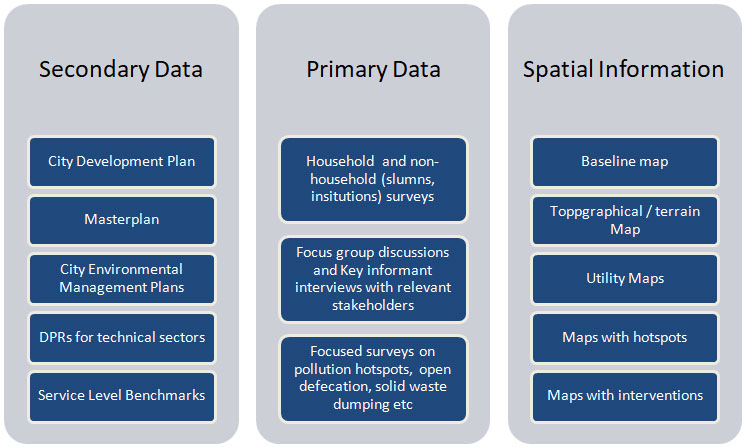Baseline Data Collection
This chapters includes information on data required for sanitation related infrastructure facilities and their current performance for wastewater and faecal sludge.

Faecal Sludge Management (FSM) is often neglected in the sanitation sector. One of the primary reasons is not having accurate or no data at all regarding on-site sanitation (OSS) facilities . Such sanitation facilities often fall out of the purview of Municipal Corporation’s responsibility, consequently, households with such OSS rely on private de-sludgers. Desludging of these on-site sanitation facilities is usually carried out manually, in absence of suitable technologies. However, ignorance about when and how frequently to desludge their OSS facility, maintenance and operational conditions often result in accumulation of organic sludge, reduction in effective volume and hydraulic overloading, which ultimately causes system failure and release of partially treated or untreated septage from the septic tank / pits. Private operators often do not transport and dispose-off septage far away from human settlements; also, they resist going to the existing STPs to dislodge their collected sludge; ‘instead, they dump it in drains, waterways, open land and agricultural fields’ (WaterAid, 2016).
With this problem in view,two types of tools have been made to help city officials plan for faecal sludge management in their city.
1) Shit Flow Diagram (SFD) - The SFD gives a clear picture of how wastewater and faecal sludge management services are delivered in a city. Primarily it provides technical and non-technical stakeholders with an easy-understood advocacy tool that can be used to support decision-making on urban sanitation planning and programming.
2) Rapid Assessment Tool (RAT) - informing them about infrastructural and financial requirements based on their data pertaining to number of properties dependent on OSS and the quantity of sludge generation etc. A ward-wise report is generated by this tool, indicating the number of on-site facilities to be cleaned in the ward on monthly basis.


